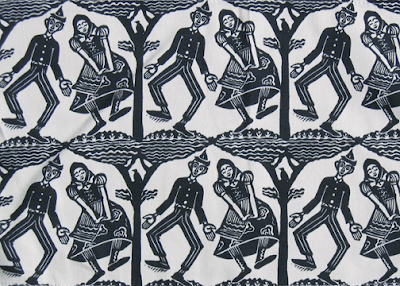
lamdha books
(reality: during c.e.c on f.h.b.)




"Brooke Goffstein had long wanted to explorethe theme of true love in a book. When shefirst heard 'Your Lone Journey' sung by JohnHartford on his album Gum Tree Canoe (Flying FishRecords), she recognized it as the exact expressionof what love is, and what real marriage means.She got Rosa Lee and Doc Watson's albumThe Watson Family (both records erroneously call it'Your Long Journey') and played the two recordingsagain and again, until several years later shecould illustrate the stanzas with color."quote: jacket flap ofYour Lone Journey










Wandered over to The Selvedge Yard again.Absolutely magnificent post on The Best Generation.As usual, JP's put together abeautifully edited group of photos.This one, in particular, stuck with me.It's remarkably timeless,somehow. Seems as though itcould've been taken in yesterday.
(Note: This was meant for the other blog; sometimes I get mixed up & post on one when it was supposed to be the other. Anyhow, think Don here is so charming figured I'd leave him. Happy Weekend.)





 Good Books, great choices, here: The 2009 Notable Books in the Language Arts...via A Year of Reading, charming blog by "two teachers who read, a lot." One of the books on the list is by Yuyi Morales, Just In Case: A Trickster Tale and Spanish Alphabet Book.
Good Books, great choices, here: The 2009 Notable Books in the Language Arts...via A Year of Reading, charming blog by "two teachers who read, a lot." One of the books on the list is by Yuyi Morales, Just In Case: A Trickster Tale and Spanish Alphabet Book.

Here, a bit more about Hughes (via gardenhistorygirl and "The Life of Langston Hughes," by Arnold Rampersad):
"...But most of the patch of earth beside the front steps, about six feet square, was barren from years of trampling by neighbourhood children, who had little time for flowers. Langston decided to rescue it, and teach the children a tender lesson at the same time. He named the plot their garden.
From Amy Spingarn’s home upstate in Dutchess County came nasturtiums, asters and marigold. Under his supervision, aided by Mr. Sacred Heart [the gardener!], each child chose a plant, set it, and assumed partial responsibility for weeding and watering the garden. On a picket beside each plant was posted a child’s name. Proud of the garden, which flourished, and prouder still of his children, Langston was photographed at least once beaming in their midst."


"Images of the universe from antiquity to the telescope will be inaugurated at Palazzo Strozzi, in Florence. The exhibition is a journey through space and time, exploring the science of the heavens and the birth of astronomy...to the achievements of the classical Greek and Roman civilizations...and...to the head of the astronomical revolution heralded by Nicolaus Copernicus, confirmed by Galileo and his telescope, and completed by such extraordinary figures as Johannes Kepler, René Descartes and Isaac Newton."Dear Reader, if you can translate the wonderful information about Peter Sis's "Starry Messenger," (see last image in post) from the folks at Rizzoli, please do let me know and I will reprint it for all to see (leave it in comments, or send me an email...I'm not picky). This new version of the starry Sis classic (more info, here) will be available at the beginning of April.And, for that little touch of class you have come to expect from art.books.children, we've included a final salute from Galileo...his preserved finger, which is housed in the Museo di storia del scienza, Firenze. A bit of the story behind it all:The Messenger from the Stars
"This short book created a revolution in astronomy – and in the history of science! Based on his observations of the moon in 1609, the Starry Messenger was published in Venice the following year. The publication was met with a storm of protest, and several rivals argued that the moons of Jupiter – which Galileo dubbed the Medicean stars – were mere artefacts caused by the faulty lenses of his telescope. But the real revolution was the use of the telescope to see celestial objects that had been hidden to the naked eye for the first time in the history of humankind.The proposal that the earth circled the sun not only shocked contemporary astronomers, but challenged the teachings of the Church, which preached that the earth was the immoveable centre of the universe. Galileo’s Dialogue Concerning the Chief Two World Systems was banned in 1632, he was forced publicly to recant his beliefs under threat of death a year later, and was placed under house arrest in Arcetri until he died in 1642. In 1992, over 300 years later, Pope John Paul II admitted the Church had been in error. Galileo has long been revered as champion of science over faith, and his middle finger preserved, in the manner of a secular saint." [Biblioteca Nazionale, Firenze]

